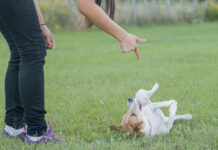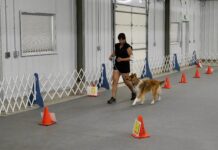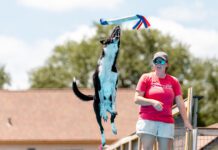[Updated November 15, 2017]
SNAPSHOT OF THE SPORT: TRACKING
What is this sport? In tracking, the dog follows a scent trail to find an article (such as a glove or wallet).
Prior training required? Minimal.
Physical demands? On the dog: Moderate. On the handler: Moderate.
Best-suited structure? Dogs of all sizes and shapes can participate, although small dogs might struggle in rough terrain.
Best-suited temperament? Dogs who are independent and enjoy making decisions are ideally suited, but many dogs love this sport.
Cost? Moderate.
Training complexity? Moderate.
Mental stimulation? High.
Physical stimulation? Moderate.
Recreational opportunities? Low.
Competition opportunities and venues? Low.
The day is very young. The sun is not yet up to help warm the bones or dry the dew-laden grass. With one exception, there is not a soul to be seen. That lone exception, bundled in layers of warm clothing, climbs out of her truck, scans the area, and smiles. There is no one in sight in this usually heavily populated urban park.
These are perfect conditions for laying a track. The scent she will leave in her wake as she walks through the wet grass will last longer in these early morning damp conditions than it would in the latter part of a warm day. And the last thing she wants after working hard to lay a good track is a carload of people arriving and unwittingly trampling the area.
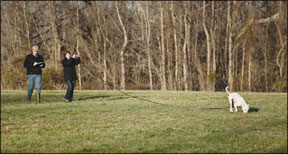
As Vicki Chaney of Garden Grove, California, unloads tracking flags, harnesses, longlines, and training bags, her Golden Retrievers, Polly and Ivy, whine and thump their tails against their crates, a joyous duet of canine anticipation.
“Being wet, cold, and muddy is not my favorite, but it is necessary to teach your dog how to work under these conditions. You have to go out tracking in the rain and wind as the dog needs to learn to track in poor weather; tests are in the winter and you’re likely to be dealing with these conditions. When I first started training for this sport, I had no idea it would change my sleeping patterns and create so much dirty laundry!”
History of Competitive Tracking
The sport of American Kennel Club (AKC) tracking started out as a stepchild to its competition obedience Utility Dog (UD) title. Although you needed to pass a separate tracking test to earn your UD title between 1936 and 1946, tracking garnered a one-paragraph description in the rules and regulations of the time.
Fans of tracking pushed for changes in the rules as a result of increased understanding of scent work and, in 1947, tracking became a separate class. The Tracking Dog (TD) title was the only tracking title available until 1980 when the Tracking Dog Excellent (TDX) title was added. Responding to the challenges of finding large amounts of land in urban areas, the Variable Surface Tracking (VST) title was added in 1995. The AKC tracking rulebook now comprises 45 pages.
Tracking titles can be obtained through several organizations, including the Australian Shepherd Club of America (ASCA) and the American Mixed Breed Obedience Registration (AMBOR), but most follow the AKC test rules (the titles listed here are AKC titles). Note that although the AKC now allows mixed-breed dogs to participate in obedience, rally, and agility, they are still not allowed in tracking. ASCA and AMBOR both have provisions for mixed-breed tracking titles.
AMBOR, for example, provides titles to people who have contacted an AKC tracking judge and made arrangements for the judge to test their mixed breed, under AKC rules, in order to attain a tracking title from AMBOR. Tracking titles, regardless of purebred status, are also available as a separate test through the United Schutzhund Clubs of America.
Dogs must be at least six months of age to enter an AKC tracking test. A dog either passes or fails a tracking test; in contrast, many other dog sports are scored, with points awarded or deducted. The dog is tested on his ability to follow a track and “indicate” that he has found the article along the track. The article is usually a glove or wallet. Advanced test levels involve longer tracks, tracks that have “aged” longer, and those that have more difficult terrain and include turns in direction.
The following are brief descriptions of the AKC tracking titles. A single “pass” earns a title.
- Tracking Dog (TD). The track is 440 to 500 yards long with 3 to 5 turns and has been “aged” for 30 minutes to two hours. The dog must “indicate” the article found. Tracks are laid in open fields with uniform cover and do not include changing terrain, roads, ditches, etc.
- Tracking Dog Excellent (TDX). The track is 800 to 1,000 yards long with 5 to 7 turns and has been aged for 3 to 5 hours. There are two sets of “cross tracks” that are diversionary only and should not be followed by the dog. The terrain is more difficult, and the dog must indicate his find of four dissimilar articles along the track.
- Variable Surface Tracking (VST). The track is 600 to 800 yards long with 4-8 turns and has been aged for 3 to 5 hours. The articles used must include one each of leather, cloth, plastic, and metal. The terrain must be comprised of three different surfaces and include a change of direction on one without vegetation, such as concrete. This more accurately tests a dog’s ability to track in an urban environment.
- Champion Tracker (CT). This title is awarded to dogs who have passed all three tracking tests. An annual Tracking Invitational is open only to dogs who have their CTs. According to the AKC, only 50 dogs have passed the VST, and only 44 have their CTs.
Before entering an AKC tracking test, a dog must be “certified” by an AKC tracking judge. Tracking tests require a lot of work on the part of many people (judges and tracklayers). Due to this, and to the time-intensive nature of each test, the number of entries is limited. The certification process ensures that a dog is truly ready for a real tracking test so that the entries go to people who have done the necessary preparation.
If a dog and handler pass the certification test, they get four certifications to use in a year. Each certification must be sent in with their entry. There is a random draw from those entries to determine who will get the available test spots.
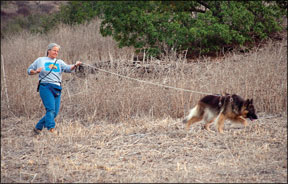
Joan Telfer of Stillwater, Minnesota, has 16 TDs and 6 TDXs on her Beagles; she’s been tracking since the early 1980s and became an AKC judge in 1993. She says that getting into a tracking test is much different from entering other sport’s competitions. “When you enter a test (TD,TDX, VST), the trial secretary accepts all entries until the closing date. Then there is a random draw to see who gets in the test and the order of the alternates.”
Training Dogs for Tracking
One might think, given the amount of time our dogs spend with their noses to the ground, that not much training would be involved in this sport. Although handlers are tapping into a natural ability of their canine friends, there is more to it than meets the untrained eye. Two things become apparent when talking to those with experience training and competing.
One is the need for the handler to “know” their dog in order to assess whether the dog is working a track or getting distracted by other things in the environment. The second is that the more a handler understands about how scent works, the better able they will be to “read” their dog’s response to the track as well as how to lay a good track.
Telfer says that this sport taught her more about her dogs than the other sports she had participated in. “I was training my Lab in obedience at a local obedience school. We were training for a CDX and I had been training him for over two years. They had started a tracking class, and all of these people were coming in with their maps and looked like they were having a great time. I asked a friend of mine what it was all about and she convinced me to try it.
“I learned how to read and handle my dog in that class. I found I love having the dogs in charge and being outdoors and watching them do something they really like. I was raising Beagles at the time and had one of them in obedience as well. She hated it so I thought maybe she would like tracking. She was a natural but, unfortunately, I was not! I pulled her off a scent too many times when she was correct.
“I started another of my Beagles and he was a natural, too. Over time, I became very good at the sport and love training and competing. I have since trained 16 Beagles to track, as well as countless students’ dogs.”
Dogs differ in how they act when they are actively working a scent and how they indicate that they have found the article placed on the track. A good tracking instructor or experienced competitor can be invaluable in helping you identify your dog’s particular way of signaling that she is working a scent. If you don’t have an instructor, you will have to learn to carefully watch your dog and notice subtle differences in how she behaves when following a track.
Since part of passing the test is to indicate the article, you as the handler must make the determination that your dog has, in fact, tracked to the article. Some handlers select from a behavior their dog offers, such as looking at the article and then looking at you. Some trainers train their dog to perform a specific behavior when they have made their find. This can be a sit, down, or nudging the handler. In either case, you as the handler, “make the call” as to whether your dog has tracked and found the article. If you make the call too early, the judge could determine that your call was premature and you will not pass the test. On the other hand, you could mistakenly think your dog has gone off the track and become distracted by a diversionary scent and inadvertently call your dog off the correct track! This is why tracking handlers often say that tracking work has taught them the most about their dogs.
Vicki Chaney decided to try tracking only because all of Polly’s Coppertop Goldens littermates had tracking titles. “I didn’t want my Polly to be the slacker of the litter. It became a joke between me and the other puppy owners. I never looked at tracking as something that could be fun. I really had very little idea what I was doing, but I thought it couldn’t be that hard! I watched a video that had been recommended to me, emailed my Coppertop friends for some advice on getting started, and then went out to the local parks and got to tracking. I soon found out that it wasn’t as easy as it looked, but I wanted that title and I was not going to quit until I got it!”
Chaney ended up getting hooked on the sport. She has a TD on three of her Goldens and a TDX on two. Early on, she was surprised to discover a hidden challenge working with eight-year-old Polly, who had both an obedience champion title (OTCH) and an agility champion title (MACH). “Her years of solid training in obedience was a huge issue and, coupled with her personality of a very polite, never wanting to make a mistake dog, the issue was made greater. Polly believed it was not okay for her to lead the way.
“In tracking it is the dog who must take the lead, showing you where the track is, and feeling confident enough to make the turns. Polly would come to a turn, stop tracking, look around, and then whine. It took me a year to figure out that she was waiting for me to give her permission to make the turn. Once I figured out what was wrong, I was able to help her understand that she had to make the decision without my permission and show me the way.”
As with many dog sports, your dog’s enjoyment of the activity will depend on how motivating you make it for him. Telfer believes that you don’t have to have a Beagle or other natural scent hound to succeed in the sport. “All dogs can do well. Highly trained obedience dogs often have trouble believing it’s not a set up [for correction]. Conformation dogs or dogs who have never been in a field may have trouble with negotiating rough cover.
“But beyond that, it is all about motivation. You need a dog, a tracking harness, a 40-foot line, and treats or toys. The hardest part is getting the handlers to trust their dogs.”
Motivation is Chaney’s top priority when starting one of her dogs in tracking. She starts with very short tracks and a super high rate of reinforcement. She starts on concrete, spraying the ground with a mist of water, and then “triple lays the track.” That is, she walks three times on the track to make sure her scent is strong. Then, she peppers the track with small bits of hot dog so that the dog follows her scent for a very short distance and gets rewarded, with the head down, with the hot dog. “As the dog eats the hot dogs, their noses are buried deep in human-scented footsteps. Human scent equals great treats!”
As the dog progresses, Chaney spaces the hot dogs further apart, lengthens the distance of the track, and introduces turns. This incremental raising of criterion lays a solid foundation for long-term success.
Team Attributes in Tracking
Telfer has seen a great variety of dogs through her years as a tracking judge. When asked if there are dangers and risks in the sport, she points out that smaller dogs might have trouble with some rough terrain and those with large, protruding eyes are at risk of eye injuries from shrubs and other ground cover. “Dogs built low to the ground can have trouble negotiating the terrain and cover, as well as injury to their belly and chest areas. The AKC does allow a dog to run while wearing protective gear.”
Many different kinds of people are attracted to tracking. However, Telfer sees a trend over the years of transient interest. “There are now a lot of people who are in it for the TD title so they can earn an AKC Versatility title (three titles in three different sports). Those people disappear after they earn their TD. Agility also seems to have claimed a lot of people’s interest.” People who stick with the sport appear to have a special connection with their dogs that comes from the close working relationship that the activity engenders.
Chaney reflects: “Polly taught me how to teach her. I began to see the wonder of scent work and how amazing it is that our dogs can find and follow a track that we laid. Watching them figure out problems as they show you how the scent changes under trees, by fences and walls, on different surfaces and in different weather, it is truly fascinating.
“I think this sport teaches you more about your dog’s body language than any other and that helps you in every other sport you and your dog train and compete in. Thanks to tracking, the relationship and communication between me and my dogs has developed to a level I never dreamed of, and it has enriched everything else we do together.”
Vicki Chaney’s Word on Her Dogs’ Competitive Tracking Careers
This is a story about canine and human communication. It took place during my second attempt to put a TDX on my youngest Golden Retriever, Ivy.
I had both Polly and Ivy entered in my first attempt to get their TDXs. Polly was 11 by then, and Ivy a comparative pup at 20 months. The two dogs couldn’t be more different in style when it comes to tracking, and I really hadn’t fully grasped that yet.
Polly drew the first track and Ivy drew the fourth track of the day. Polly, not being very confident in taking the lead, likes me to verbally encourage her throughout the track. This helps her stay focused on her task since my chatter lets her know I approve of her work, and that is very important to Polly. Ivy, on the other hand, is very confident in her tracking and is comfortable taking the lead. She knows her job and I rarely talk to her as we run a track; something I had not given much thought to.
Polly ran her track beautifully, earning her TDX. When it came time to run Ivy, I was still in “Polly mode,” chattering away, and I made a series of mistakes. The most critical was when I yelled, “Yes, good girl,” as Ivy paused with her nose buried deep in the footsteps of the cross-track layer! Good dog that she is, Ivy responded to my poorly timed verbal encouragement and went off on the cross track, causing us to fail. She understood our mistake when they allowed me to pull her off the cross-track, put her back on the correct track, and finish.
At my second TDX test with Ivy two weeks later, I was focused only on her. I had learned my lesson and kept my mouth shut. As we came to the first set of cross-tracks, with her nose buried deep in the cross-track layer’s step, she spun around, looked up at me, nose still to the track, as if to say, “Are you calling this or am I?”
I stood there like a deer in the headlights and didn’t dare make a sound! Had I not wanted so badly to pass the test, I would have burst into laughter at the sight of her expression!
After making her point, she turned around and continued on. Upon reaching the second set of cross tracks, she simply paused with her back to me letting me know they were there and that my options were still open. Again, I was silent. I am trainable! Ivy then continued on down the track, earning her TDX. What a good girl — both of us!
– Vicki Chaney
Tracking Equipment and Expenses
The cost of training classes, when you can find them, varies depending upon where you live. Telfer finds that 4- to 6-week classes run $50 and up. Entry fees can run $50 to $100 due to the expenses of putting on a tracking test. Telfer’s experience is that a TD test runs $50 to $60, while a TDX or VST can easily top $100.
Equipment costs are minimal, but travel and lodging can add up if you need to travel to test sites.
Do you have a dog who is not ready to compete in other sports due to the physical demands of those activities? Do you have a dog who is retiring from other sports? Do you have a dog who loves to use his nose? Then get tracking!
Terry Long, CPDT-KA, is a writer, agility instructor, and behavior counselor in Long Beach, CA. She lives with four dogs and a cat and is addicted to agility and animal behavior.


